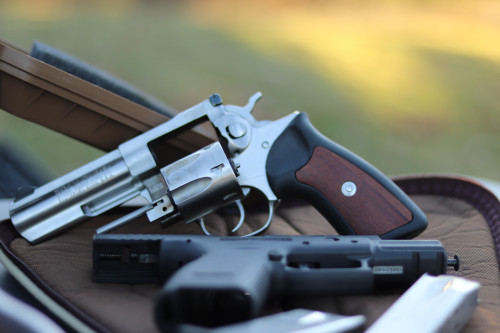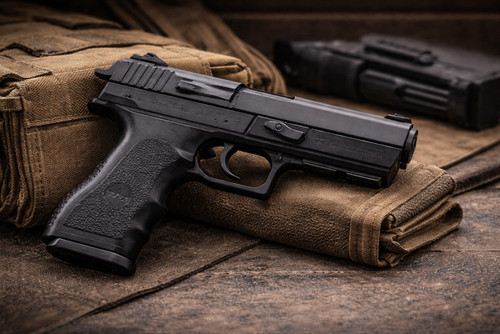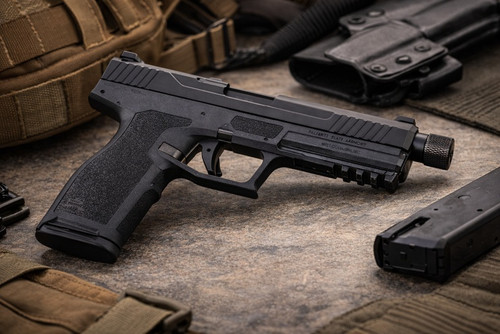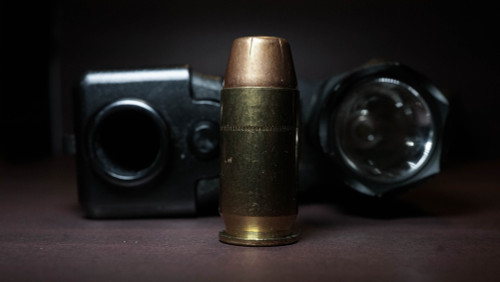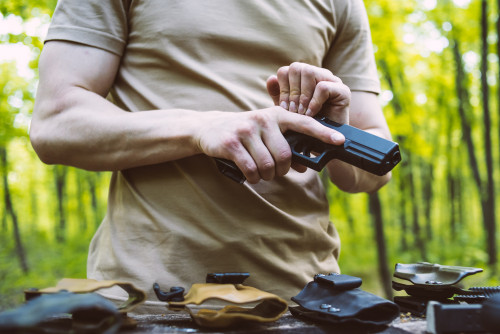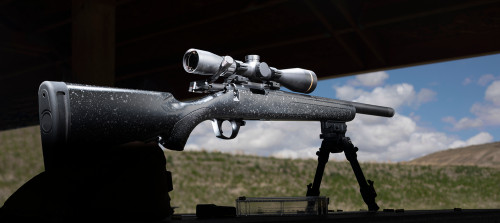Over the past few decades, and especially the last four years, firearms ownership has positively exploded in our nation. To put things in perspective, for the past 48 months, over a million firearms per month have been sold at gun shops around the country. While for various reasons most people won’t cop to owning a gun when asked, the simple fact is that Americans are arming up like never before.
Men and women of all walks of life are embracing their right to keep and bear arms. Along those lines, responsible citizens are learning how to use their firearms safely and effectively. Many of them are also parents, and have serious (and legitimate) concerns about children and guns.
You want to teach your kids to shoot and handle firearms safely and with respect. You’re most likely concerned with how to introduce the little ones to the world of responsible firearms ownership in a safe, serious (and fun) manner. You also may have concerns about safely storing your guns in a way that keeps them secure from curious hands, while still accessible for emergency use.
Here, we’ll show you the reasons why teaching your kids about guns is an important American tradition and offer practical, engaging ideas to instruct your kids on how to be safe around guns — and how to shoot guns themselves.
Times Have Changed: The History of Firearms and Family
By teaching your kids to shoot, you are carrying on a tradition that predates our nation’s independence.
In the colonial era and beyond, learning about firearms was part and parcel of life. Whether it was a family of hardy pioneers pushing westward, or city folk building up the foundations of government and business, everyone knew about guns. In fact, most owned at least one serviceable weapon (usually a musket).
Naturally, children were expected to learn the basics of safe gun handling and marksmanship. Formalized military training wasn’t common, so the lessons of safe and effective firearms use were taught in the home, passed down usually from parents to children. Though it was mainly a father-to-son affair, daughters were also encouraged to have a basic familiarity with the family “arsenal,” since shooting skills could prove useful in an emergency.
As the United States grew and urbanized, the character of the nation changed. The rough and ready pioneer lifestyle was supplanted by a more structured and ordered society. Instead of seeing hardworking newly-independent Americans bearing arms for defense and taking game, you’d see them settling into a comparative life of luxury and convenience. Stores where prepared food was purchased took the place of farmers’ markets and hunting, and defense was considered more of a military and police function.
Especially after the Civil War, the percentage of the nation who owned guns decreased. Of course, it didn’t mean that the right to keep and bear arms was somehow suppressed — it was just that cultural mores treated guns and learning about guns as “optional.”
In modern times, this trend continued and had consequences. Starting after World War II, entire generations were growing up without even touching a firearm. They weren’t enrolled in the Scouts, and schools were canceling their rifle teams and marksmanship classes. Even air rifle teams were becoming a thing of the past.
With the dawn of the 21st century and the topic of guns (especially kids and guns) being a hot-button political and news item, many people took interest in firearms again, whether as a hobby or for practical reasons such as self-defense. Not having a parental figure to teach them the rules and best practices of firearms safety, many of these new gun owners had to pick up the basics from sources such as websites and Youtube videos. Many also invested time and money learning from professional firearms instructors.
Today, these traditions are being revived, and gun owners of all stripes are looking to pass on the skills of safe firearms handling to the next generation.
In that, learning about guns is one thing. Teaching is another. You may know everything there is to know about guns, but conveying that knowledge, especially to a youngster, takes patience, care, and an ability to demystify concepts that are potentially scary to a child.
The Four Rules Of Firearms Safety
As a responsible and careful firearms owner, you may know about firearms safety already. The rules may be second nature to you. However, that isn’t so with a child who is new to guns. The basic rules of firearm safety are the first things you need to drill with your child when teaching them about firearms. Start them off right, and they will be model firearms owners for life.
As a refresher, here are the four primary rules of gun safety:
1. Always Keep The Firearm Pointed In A Safe Direction
Only point it at something you intend on shooting. Keeping the gun pointed in a safe direction minimizes the risk of injury or worse if there is a negligent discharge of the firearm. Even when dry firing or using an Airsoft/BB gun, this practice should be maintained to help build good habits in the child learning about guns.
2. Treat Every Firearm As if It Were Loaded
Whenever you are handed a firearm you don’t intend to shoot right away, work the action (rack the slide, pull the charging handle, etc.) and ensure the weapon is clear. Do the same when handing a firearm to someone else. Repeating this builds better safety habits. Firearms should only be loaded when at the range or for carry.
3. Keep Your Finger Off the Trigger Until You Are Ready To Shoot The Gun
Trigger discipline is one of the most important aspects of firearm safety, especially for kids. When drawing the weapon or raising it to fire, your finger should be above the trigger. This is known as “indexing” the trigger. It lessens the chance of a negligent discharge. Even if the safety is engaged (on a firearm with a manual safety), this practice should always be observed. Safeties can fail. The ultimate safety is you, the operator of the firearm.
4. Always Be Sure of Your Target and What Is Beyond It
This doubles as an excellent lesson in physics as well. Even the humble .22 LR projectile can penetrate drywall and keep going. A more powerful cartridge such as 7.62x51mm NATO can easily travel two miles or more if not stopped by a solid object. Always be sure of what you’re shooting, and make sure there is nothing behind the target that you don’t intend to shoot.
Other Safety Considerations and Tips
While the basics are important, you’ll want to have extra safety measures with your children. To be fair, kids can be trained to use firearms safely and effectively, but they are still young. Kids make mistakes, and it’s important to take precautions to ensure they are learning in as safe of an environment as possible. Here are some extra tips to protect your family:
1. Use Ear Protection
The sound of a gunshot is insanely loud, even more so in an enclosed space such as an indoor gun range. A 5.56mm AR-15 clocks in at over 150 decibels. The famous .30-06 cartridge is even louder at over 160 decibels. For reference, a loud rock concert is around 130 decibels. Ear protection such as foam earplugs designed for gun ranges or full-sized noise-canceling earmuffs are a must, especially for the sensitive ears of a child. Otherwise it could seriously damage their ears. Most gun ranges will stock child-sized earmuffs, but it’s good to have a backup pair in case you’re shooting on private land.
2. Use Eye Protection
There are multiple ways your eyes can be injured when operating a firearm. Burning gunpowder is mildly irritating. Fragments of a bullet that strikes a solid object can ricochet back at you. A malfunctioning firearm can fail and pieces can fly up into your face. Small droplets of unburned lubricant can also spray backwards. Equip your kids with safety glasses when shooting — and be sure to pick up a pair for yourself.
3. Keep a First Aid Kit
If you’re shooting at an indoor range, they’ll have plenty of first aid supplies on hand. Whether it’s a minor wound (like a cut), or something bigger, you’ll want to address injuries right away. If you are shooting outdoors, you’ll most likely need a first aid kit of your own. Indoors or out, it’s good to have a small kit with you — even for everyday carry.
4. Stay Clean
While modern ammunition has less toxic compounds in its composition, it’s still good practice to clean yourself up thoroughly after a range trip. Burning gunpowder, though termed “smokeless,” releases vapors upon ignition. The heat can also cause the lead to vaporize a small part of the bullet. Some of that matter can land on you, and over time, become a health hazard.
After every range session, have all participants in your group clean themselves up. Indoor ranges will usually have restrooms equipped with “deleading” soap dispensers. This is especially important for children as they are more sensitive to the various compounds in ammunition.
5. Buy a Suppressor (If Funds and Laws Permit)
Certain states prohibit suppressor ownership entirely, and even in states that permit suppressors, they are extremely regulated by the federal government. Often, they take about six months to acquire legally. Firearm suppressors (aka silencers) make the experience of shooting a firearm much more enjoyable, especially for first-time users.
While in reality they don’t “silence” a gun (like you see in movies), suppressors significantly reduce the concussive blast of a gunshot. A good suppressor will damp down the 150 decibel blast of a 5.56mm round to below 130 decibels. Still loud (and you should still wear ear protection) but not as much as an unsuppressed shot. On a small .22 LR pistol or rifle, the noise can be dampened to below 110 decibels. Not having to deal with the concussive blast allows new and young shooters to focus more on the fundamentals of aiming and trigger manipulation. Pair a suppressor with subsonic ammo for an even quieter shot.
6. Store Your Guns Safely When Not in Use
In today’s world, you will find most people are purchasing firearms for the serious task of defending themselves and their loved ones. For an effective defensive strategy, you want to have a firearm that’s readily accessible in an emergency, but secure enough to keep curious and untrained people of all ages from easily accessing it.
The most common setup in a gun owner’s home these days is to have two gun safes. You should have one quick-access safe (opened via a biometric method such as a fingerprint) that contains a loaded handgun for emergency use, and another safe for your firearms that aren’t for emergency use. This can be a “true safe” such as a Liberty Safe (similar to one you would see in a jewelry store) or a “residential security container” which is of sufficient strength to block casual curiosity (i.e. kids in the house). Thieves looking for a quick score will also have trouble with this kind of safe.
7. Knowledge Is Power
It’s wise to instruct children not to fear guns, but to respect them. Let them know about the dire consequences or misusing them. “Just playing” can result in serious injury and death. If they see an unattended firearm they should immediately seek the help of a nearby adult who can safely handle the gun.
Of course, as responsible gun owners, we don’t leave our guns unattended, but knowing what to do if an unattended gun is discovered is an invaluable skill. Repeated lessons and exercises on safety demystify and make guns “part of life” just as much as the family car. You know a car is useful and can even be fun, but misusing a car or getting in its way can be tragic.
What Age Can a Kid Shoot a Gun (and Other Legal Considerations)?
It’s almost never too early to teach your kids about firearms. Even if you can’t teach them how to shoot a gun just yet, you can teach them about firearm safety — as soon as they can understand what you’re saying. The earlier you can make them familiar with the dangers and proper handling of firearms, the safer they’ll be.
Across the United States, there aren’t many laws against teaching young kids how to shoot a gun (since you, a responsible adult, will be supervising them). While all children develop at different rates, your child might be able to learn how to shoot a gun when they are anywhere between three and seven years old (depending on their cognitive and physical abilities). However, it’s quite common for shooting ranges to only allow kids twelve and older to shoot. This means you might need to have these live shooting lessons on private land until your kids come of age.
That said, many states have other laws concerning firearms and children, which you’ll need to keep in mind as you introduce guns to your family.
Usually, these laws concern minors having unsupervised access to firearms. For example, if you aren’t home, your 12-year-old should not be able to access any firearms in the house. Of course, those laws are punitive in nature — you won’t be subject to surprise inspections from the police, but there will be legal penalties if a child accesses your guns and something tragic happens.
In some jurisdictions, the laws are much more strict when it comes to firearms and children, usually concerning access. For example, in Hawaii, if authorities determine a child gained access to a firearm, loaded or unloaded, through your negligence, criminal charges can be filed. Even if nothing tragic happens, you could find yourself an unwilling guest of the state if caught. Negligence could mean leaving the gun in a drawer or even something as simple as putting the combination to the gun safe on a sticky note in the bedroom.
As the laws vary from state to state, and you’ll want to research the laws concerning children and firearms in your area.
Practical and Fun Training Ideas
With all that serious safety and legal stuff in mind, let’s get to the actual business of teaching a child how to shoot.
Demystifying guns and making them “part of the landscape” to young people in your household means building up their confidence in using them.
While firearms training is serious business, it can also be fun. Part of that fun involves being able to confidently use the weapon. The key is to impart the gravity of what the firearm can do if handled improperly, while also instilling a sense of responsibility and confidence in the child who is interested in guns.
1. Use Air Rifles and Airsoft Replicas To Teach Fundamentals
A good way to give your kids confidence in handling guns (and keep them safe) is to start them off easy. Beyond their uses in military simulation and live-action role-playing, Airsoft and airguns (aka BB Guns) can teach kids the basics of loading, making ready, and operating a real firearm.
Most common firearms have Airsoft/air-propelled clones and replicas. Often, the major firearms manufacturers such as GLOCK and H&K will have a company such as UMAREX make CO2 or air-powered replicas of their weapons. The action of the Airsoft replica is usually quite close to the real thing.
However, since an Airsoft gun does fire a plastic or paintball round at a few hundred feet per second, the Four Rules Of Firearm Safety still apply. That being said, the lack of a “bang” allows a child to concentrate on the fundamentals of safety and accuracy, building confidence. Furthermore, with the proper protective equipment, you and your child can engage in some force-on-force fun. In the real world, professionals such as police officers will often use Airsoft replicas to train against each other in realistic scenarios.
2. Dry Fire and Laser Training Aids
Dry fire is the simplest and most cost-effective firearms training available. First, ensure that the firearm is unloaded and that the Four Rules are still observed. Then press the trigger to get a feel for its weight, break, and reset. This also helps address issues with grip and stance.
Along the same lines, most modern firearms can be fitted with a laser training cartridge, which is basically a bullet-shaped laser pointer that fits inside the chamber of the gun. Pressing the trigger causes the firing pin or striker to tap a button on the back of the training cartridge, causing the familiar red dot to turn on briefly. You can see if you’re shaking the gun when pressing the trigger, as the dot will wobble.
The more sophisticated dry-fire training kits will also include a set of target sensors which can even wirelessly report back to a companion iPhone or Android application, providing statistics on your accuracy, stability, and time. Better yet, these kits can be used in the comfort of your home, providing a familiar place for a child to learn about the firearms available to them (without using live ammo).
3. Interactive Video Target Shooting
The newest firearms ranges often feature an interactive shooting experience for their customers. You’ll use real ammunition and your own firearms and engage targets on a special screen downrange. A system of laser and sonic sensors determines your hits.
It’s basically a video game, but with real ammunition and real firearms. The classics have been ported over to most of these systems — play Asteroids or Missile Command, except here the controller is your firearm. With most kids feeling “at home” with video games these days, this adds another level of engagement and fun to the world of firearms while still helping them train effectively.
4. Shooting .22 Long Rifle Guns
A lot of us gun owners who grew up with firearms got our start learning on guns chambered in .22 LR. A small round, .22LR offers the perfect platform for training youngsters, as the recoil is about as low as you can get with a legitimate cartridge.
Today, you can still find many “youth” guns (like the Cricket) chambered in .22LR. WEE1 Tactical even makes an AR-15 replica chambered in .22LR. This training rifle (called the JR-15) is sized perfectly for a younger shooter. It also sports a specialized safety system tuned for an adult to operate easily, while preventing a child from easily operating the gun without supervision.
Glock also offers a .22LR version of their ubiquitous Glock 19 called the Glock 44.
Trying “youth” variants of modern firearms that they can use and enjoy will make teaching children the fundamentals of safe firearms handling easier.
Final Thoughts
Effective, safe, and responsible firearms use is part of the heritage of our nation. Passed down from generation to generation, the teaching of marksmanship and shooting fundamentals instills a sense of responsibility and self-reliance in a young person.
As an adult, you’re responsible for teaching your child or children that guns are tools with many valid uses, including sport, hunting, and defense. With careful and repeated instruction in the safe handling of firearms, kids of nearly any age can be taught to responsibly handle and enjoy the operation of firearms. Showing your children that firearms are part of life will go a long way towards stifling any fears they may have of guns.
On a more personal level, teaching kids how to shoot a gun at any age is a time-honored and great way to bond over one of the foundational traditions of our country. Teaching someone else, whether it’s a child or another adult, about the safe handling and operation of firearms is also an excellent way to refine and refresh your own skill set.
Looking for affordable, lockable cases for your guns, individual first aid kits, and other firearms safety supplies? Pro Armory has everything you need to safely store your firearms, and keep your kids safe and able to enjoy using guns. If you want to learn more about firearms safety and dry fire training tips for you and your family, we’ve got you there, too. Sign up for our newsletter to be informed when Pro Armory’s online firearms training officially launches.





